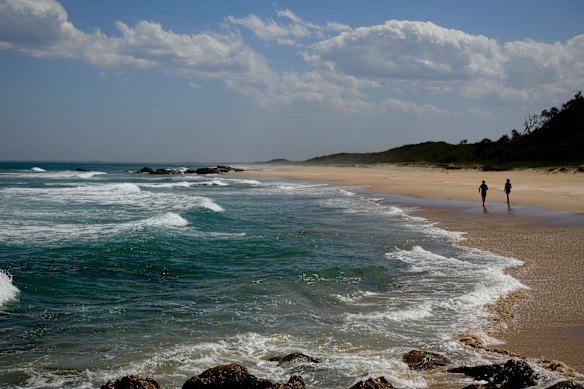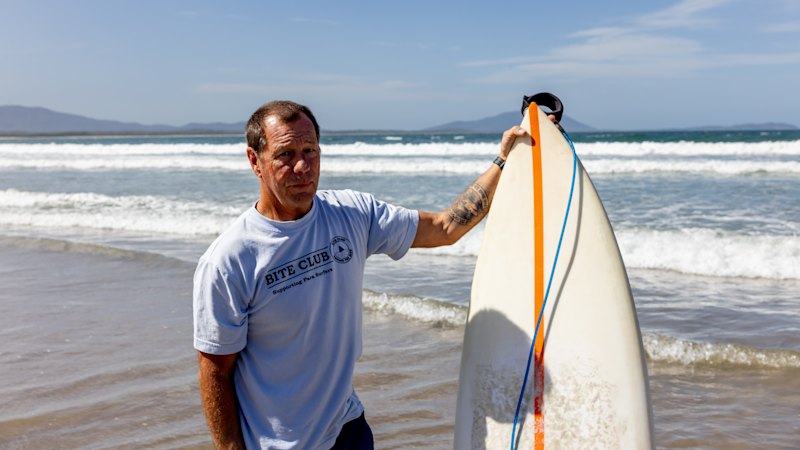“I was kind of OK with it, and it was a scary thing,” Pearson said.
“That was a scary thing – I was fine with dying.”
Then he thought of his kids, his partner, and told himself there was more left to give.
“I felt the sand under my feet and pushed as hard as I could and got back on the surface,” he said.
Refusing to die, put his forearm “back on again”, tried to stem the bleeding and, with the help of two surfers in the water, made it back to the beach.
Shortly after Thursday’s attack, drum lines and drones were deployed to locate the shark believed to have been involved in the attack. But with no shark receivers, which ping when a tagged animal swims within 500 metres, in the area, authorities face an increased challenge to locate the shark.
Lukas Schindler survived Thursday’s shark attack at Kylies Beach. In August he completed the Sydney Marathon.
Police are now reviewing the footage from the Swiss couple’s GoPro that captured the interaction with the pod of dolphins to confirm the suspicion a bull shark was involved in the attack as they prepare a report for the coroner. It is unclear whether the attack itself was captured on camera. Schindler remained in Newcastle’s John Hunter Hospital in a stable condition on Friday.
Locals and campers said bull sharks were regularly spotted along the stretch of coast between Kylies Beach and the mouth of the Manning River, about seven kilometres south of Crowdy Head. The river is a known breeding ground for the species.
Receivers are in place at 37 beaches along the NSW coast, from Bega to Tweed Heads, but there are few on the Mid North Coast. The closest to Kylies Beach is located at Old Bar, about 30 kilometres south.
Without shark receivers in the area, Pearson, who founded shark and animal attack survivor support group Bite Club, said educating swimmers and surfers when it was safe to enter the water was key to reducing attacks.

Kylies Beach in Crowdy Bay National Park, where a young woman died and a young man was seriously injured after being bitten by a bull shark.Credit: Dean Sewell
Bite Club has grown to about 600 members worldwide in the past 12 years and includes survivors of lion, crocodile, bear and hippopotamus attacks.
On Friday, Pearson was the only one of his usual crew at the beach. Not only did he want to be among the waves, getting back in the water after Thursday’s attack was something he needed to do.
In July, surfer Kai McKenzie lost his right leg when a great white shark attacked him off North Shore Beach in Port Macquarie. He survived after fighting the shark off and catching a wave in to shore. In the months since, McKenzie, who now has a prosthetic leg, has returned to the water.
Loading
A tattoo on Pearson’s left forearm covers the scars of his attack and serves as an equally permanent reminder of how far he’s come. The word “SURVIVOR” is inked into his skin above an image of a bull shark and the date he fought for, and kept, his life.
“When you nearly die, life has a different aspect from there on, and you’ve got to try to look at a bit different,” Pearson said.
“It’s not always easy, but life is great. I try, every day, to be great because it’s worthy of it.”
On Kylies Beach, 4WD tracks snaking along the sand were the only visible sign of Thursday’s tragedy.
There were no flowers laid in tribute, no grieving family or friends, no marker of the pain being felt along the coast and across the ocean.
Beyond the fallen police tape and down the track emergency services followed on Thursday morning, the only sound to be heard was the crashing of waves cracking like gunshots carrying along the beach.
There were no screams, no calls for help, no thrum of a helicopter. Only the rising tide washing away any trace of a day that had taken one life and changed another forever.
Start the day with a summary of the day’s most important and interesting stories, analysis and insights. Sign up for our Morning Edition newsletter.
Read the full article here

